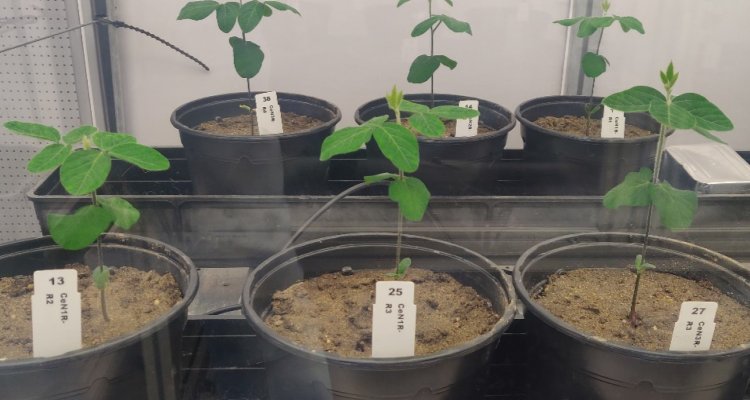
Project
SyN-PHOT: N fixation and photosynthesis under elevated CO2
In a rapidly changing climate, rising CO2 levels potentially boost photosynthesis, but increases the demand for N. Soybean plants can partly acquire this N by symbiotic N-fixation. This is an energy demanding process, requiring up to 30% of the plant’s photosynthates. To ensure that elevated CO2 can be utilized to its full photosynthetic potential, without the need for additional N fertilizer, an energetically cost-effective C/N balance for symbiotic N-fixation is needed. This project investigates this C/N balance to understand trade-offs and realize a yield potential increase without an increased need for N fertilization.
Background
Our climate is changing rapidly. Anthropogenic activity has led to a 50% increase in atmospheric [CO2] over the past 250 years, largely contributing to the so-called greenhouse effect. Apart from indirectly effecting plant growth through the long-term impact elevated [CO2] has on the earth’s climate, it also effects plants more directly by boosting photosynthesis.
Photosynthesis has not yet reached its theoretical maximum potential and therefore provides an opportunity to realize a much-needed increase in yield of C3 crops in particular. However, increased photosynthetic potential comes at a cost. High levels of fixed carbon disrupts the carbon/nitrogen (C/N) balance of plants, ultimately increasing the demand for fixed nitrogen.
Field experiments revealed that some soybean cultivars can partially overcome this N-shortage under high [CO2], most probably due to their N-fixing nodulation trait. However, symbiotic N-fixation is an energy-demanding process, which requires approximately 30% of the total plant photosynthates. On the other hand, photosynthesis is a highly N dependent process and therefore requires sufficient N to reach its full potential. This co-dependency means that elevated [CO2] largely impacts carbohydrate and organic N allocation and source-sink relations, which are key for many yield related crop traits. Lastly, elevated [CO2] has direct impact on the abundance and ultrastructure of the chloroplasts themselves, to facilitate the increase of CO2-assimilation, in an N-dependent fashion.
To ensure that future increases in [CO2] can be utilized to its full photosynthetic potential and realize a yield potential increase without an increased need for N fertilization, an energetically cost-effective C/N balance for symbiotic N fixation is required.
Recent research revealed that N-fixing root nodule symbiosis likely has a single evolutionary origin (~110 million years ago), followed by massive parallel losses of this trait in many plant lineages. Loss of nodulation correlates with a reduction in atmospheric [CO2], and it was suggested that due to its high C costs, N-fixing symbiosis is no longer beneficial when the photosynthetic potential of a plant decreases. As a result of the evolution of this trade-off between photosynthesis (source) and symbiotic nitrogen fixation (sink), it is likely that the benefit of increased photosynthesis at elevated [CO2] is underutilized due to the intrinsic regulation of nodule formation. This potentially reduces both primary production as well as N use efficiency in future climates.
Project description
This project will setup an experimental system to analyze the effect of elevated [CO2] on plant performance. The innovative nature of the project is the design, build and testing of an experimental growth system that enables treatment and labelling of individual plant organs with stable isotopes of 13CO2 and/or 15N2 independently.
By combining expertise, this project will create synergy to investigate to what extent increased [CO2] effects photosynthesis, N metabolism and C/N allocation within the plant. Experiments include a range of N and CO2 levels (and combinations thereof), on wild-type and nodulation mutants, ranging from no nodules, few functional nodules to hyper nodulating. Dr. Driever (CSA) will analyse the photosynthetic CO2 assimilation and light use efficiency of photosystems of leaves, as well as the allocation of C and N to plant organs by stable isotope labelling. Dr. Kohlen (MOB) will focus on analyzing the effect on nodule biology, rhizobia bacteria and primary plant metabolites (Amino acids and Sugars). Dr. Gommers (PPH) will focus on chloroplast development and structure in response to changes in CO2 and N availability.
To identify interactions between gas (CO2 and N2) availability and physiological traits (e.g. sink-source, photosynthetic potential and chloroplast morphology), the project will integrate the generated data to develop a conceptual model framework. By using Soya (Glycine max) as a model, the research can investigate the effect of symbiotic nitrogen fixation on these processes in a C3 crop species, making the experimental outcome of the proposed work directly applicable to an agricultural system.
Apart from the experimental system and fundamental knowledge that the project will generate on the effect of elevated [CO2] on photosynthesis, nodulation and crop physiology, it will link below and aboveground processes, establish a model system and conceptual model framework, which can be readily put into a crop context. However, our research should also be viewed from its sustainability aspect. The United Nations’ Food and Agriculture Organization (FAO) estimates that to meet the predicted global demands by 2050 a 70% increase in food production is required. Today, almost all of the top-quality farmland is already being used for agriculture. This means that -if any- future expansion of farmland can only occur on nutrient-poor soils. It is unlikely that these soils will sustain the high yields required. It is therefore inevitable that, in addition to increased crop production, resource-use efficient crops need to be created. The conceptual model generated by the proposed research could serve as a blueprint for this.